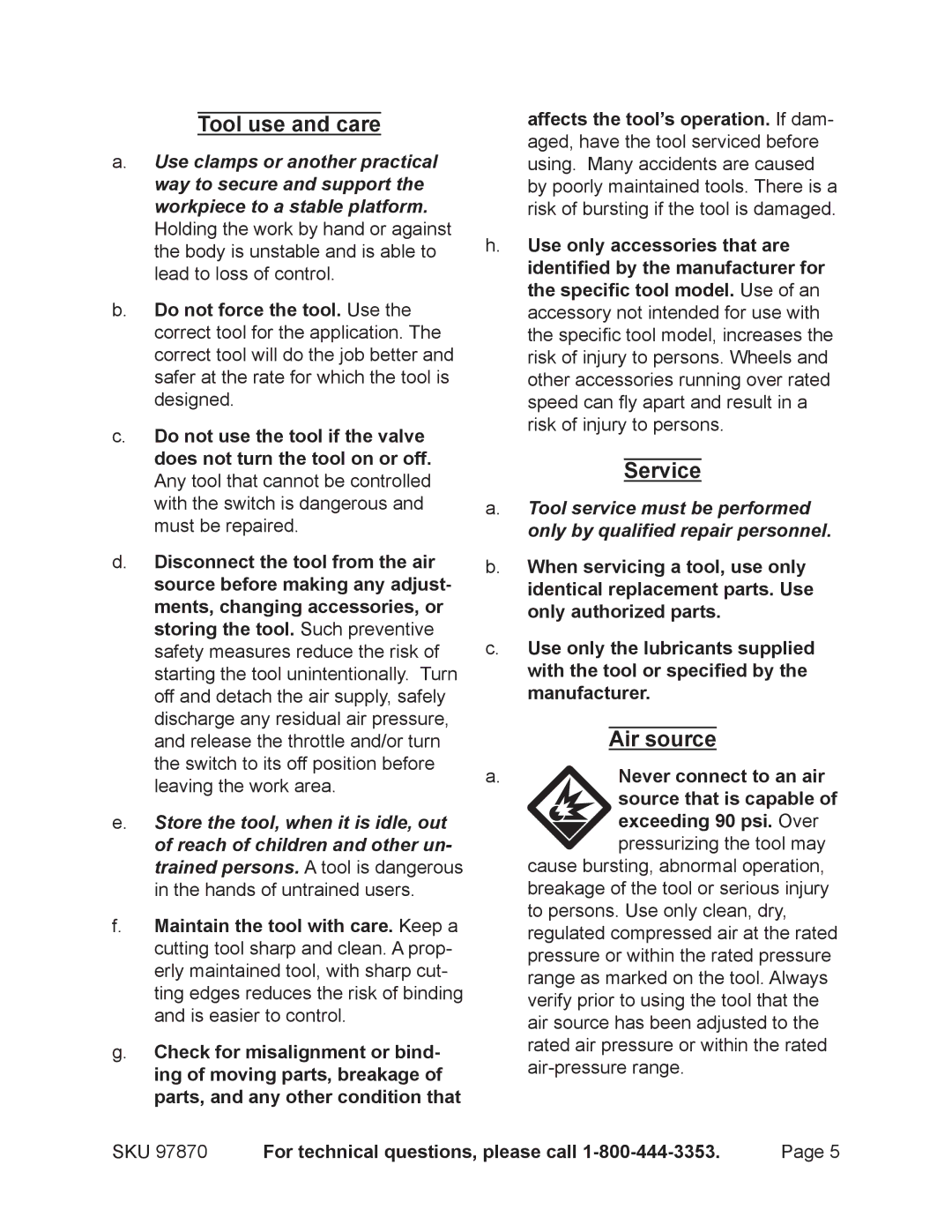
|
|
|
|
| affects the tool’s operation. If dam- | ||||||
|
| Tool use and care |
| ||||||||
a. | Use clamps or another practical |
| aged, have the tool serviced before | ||||||||
| using. Many accidents are caused | ||||||||||
| way to secure and support the |
| by poorly maintained tools. There is a | ||||||||
| workpiece to a stable platform. |
| risk of bursting if the tool is damaged. | ||||||||
| Holding the work by hand or against | h. | Use only accessories that are | ||||||||
| the body is unstable and is able to | ||||||||||
| lead to loss of control. |
| identified by the manufacturer for | ||||||||
b. | Do not force the tool. Use the |
| the specific tool model. Use of an | ||||||||
| accessory not intended for use with | ||||||||||
| correct tool for the application. The |
| the specific tool model, increases the | ||||||||
| correct tool will do the job better and |
| risk of injury to persons. Wheels and | ||||||||
| safer at the rate for which the tool is |
| other accessories running over rated | ||||||||
| designed. |
|
|
| speed can fly apart and result in a | ||||||
c. | Do not use the tool if the valve |
| risk of injury to persons. |
| |||||||
|
|
|
|
|
|
| |||||
| does not turn the tool on or off. |
|
|
|
|
|
|
| |||
|
|
|
| Service |
| ||||||
| Any tool that cannot be controlled |
|
|
|
| ||||||
| with the switch is dangerous and | a. | Tool service must be performed | ||||||||
| must be repaired. |
| only by qualified repair personnel. | ||||||||
d. | Disconnect the tool from the air | b. | When servicing a tool, use only | ||||||||
| source before making any adjust- |
| identical replacement parts. Use | ||||||||
| ments, changing accessories, or |
| only authorized parts. |
| |||||||
| storing the tool. Such preventive | c. | Use only the lubricants supplied | ||||||||
| safety measures reduce the risk of | ||||||||||
| starting the tool unintentionally. Turn |
| with the tool or specified by the | ||||||||
| off and detach the air supply, safely |
| manufacturer. |
| |||||||
| discharge any residual air pressure, |
|
|
|
|
|
|
| |||
| and release the throttle and/or turn |
|
| Air source |
|
| |||||
| the switch to its off position before | a. |
| Never connect to an air | |||||||
| leaving the work area. |
| |||||||||
|
|
| source that is capable of | ||||||||
|
|
|
|
|
|
| |||||
e. | Store the tool, when it is idle, out |
|
| exceeding 90 psi. Over | |||||||
| of reach of children and other un- |
|
| pressurizing the tool may | |||||||
| trained persons. A tool is dangerous |
| cause bursting, abnormal operation, | ||||||||
| in the hands of untrained users. |
| breakage of the tool or serious injury | ||||||||
f. | Maintain the tool with care. Keep a |
| to persons. Use only clean, dry, | ||||||||
| regulated compressed air at the rated | ||||||||||
| cutting tool sharp and clean. A prop- |
| |||||||||
|
| pressure or within the rated pressure | |||||||||
| erly maintained tool, with sharp cut- |
| |||||||||
|
| range as marked on the tool. Always | |||||||||
| ting edges reduces the risk of binding |
| |||||||||
|
| verify prior to using the tool that the | |||||||||
| and is easier to control. |
| |||||||||
|
| air source has been adjusted to the | |||||||||
|
|
|
|
|
| ||||||
g. | Check for misalignment or bind- |
| rated air pressure or within the rated | ||||||||
|
| ||||||||||
| ing of moving parts, breakage of |
|
| ||||||||
|
|
|
|
|
|
|
| ||||
| parts, and any other condition that |
|
|
|
|
|
|
| |||
SKU 97870 | For technical questions, please call | Page 5 | |||||||||
